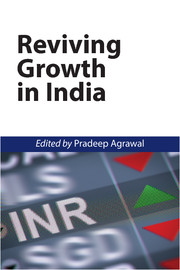Book contents
- Frontmatter
- Contents
- List of Tables and Figures
- Preface
- Section 1 The importance of growth
- Section 2 Reviving growth of industry and exports
- Chapter 3 Sustaining a High Rate of Industrial Growth in India in the Next 10 Years
- Chapter 4 Growth Drivers: ICT and Inclusive Innovations
- Chapter 5 Determinants of India's Service Exports
- Section 3 The dampeners to growth: Controlling inflation
- Section 4 The supply constraints to growth
- Section 5 Emerging issues in growth: The labour and capital markets
- Contributors
- Index
Chapter 3 - Sustaining a High Rate of Industrial Growth in India in the Next 10 Years
from Section 2 - Reviving growth of industry and exports
Published online by Cambridge University Press: 18 December 2015
- Frontmatter
- Contents
- List of Tables and Figures
- Preface
- Section 1 The importance of growth
- Section 2 Reviving growth of industry and exports
- Chapter 3 Sustaining a High Rate of Industrial Growth in India in the Next 10 Years
- Chapter 4 Growth Drivers: ICT and Inclusive Innovations
- Chapter 5 Determinants of India's Service Exports
- Section 3 The dampeners to growth: Controlling inflation
- Section 4 The supply constraints to growth
- Section 5 Emerging issues in growth: The labour and capital markets
- Contributors
- Index
Summary
INTRODUCTION
India's new National Manufacturing Policy (announced in 2011) aims at raising the share of manufacturing in aggregate Gross Domestic Product (GDP) from about 15 per cent at present to about 25 per cent by 2022 (or thereabout), and creating in that process an additional 100 million jobs. Achievement of this goal requires the real output of India's manufacturing to grow at the average rate of about 15 per cent per annum in the next 10 years if one assumes that the aggregate GDP will grow at the rate of 10 per cent per annum in that period. The required growth rate in real output of India's manufacturing is about 13 per cent per year if the growth rate in aggregate GDP in the next 10 years is taken to be lower at about 8 per cent per annum. During the period 1999–2000 to 2011–12, the trend growth rate in aggregate GDP was 7.7 per cent per annum and that in manufacturing GDP was slightly higher at 8.3 per cent per year. According to first revised estimates of national income released by the Central Statistical Office (CSO) (Press note dated 31 January 2014) and advanced estimates of national income released by the CSO (press note 7 February 2012), the growth rate in real GDP in manufacturing in 2012–13 over the previous year was 1.1 per cent, and that in 2013–14 is expected to be –0.2 per cent. Thus, the average growth rate in manufacturing GDP during the period 1999–2000 to 2012–13 was less than 8 per cent per year, which holds true also for the period 1999–2000 to 2013–14. Evidently, a huge increase in the growth rate in manufacturing real output (by 5 per cent or more) would be required if the target of enhancing the share of manufacturing in aggregate GDP to 25 per cent within a decade is to be achieved. Is such an increase in the growth rate of manufacturing real GDP possible and sustainable, and if so, what does it entail?
- Type
- Chapter
- Information
- Reviving Growth in India , pp. 47 - 81Publisher: Cambridge University PressPrint publication year: 2015
- 1
- Cited by

